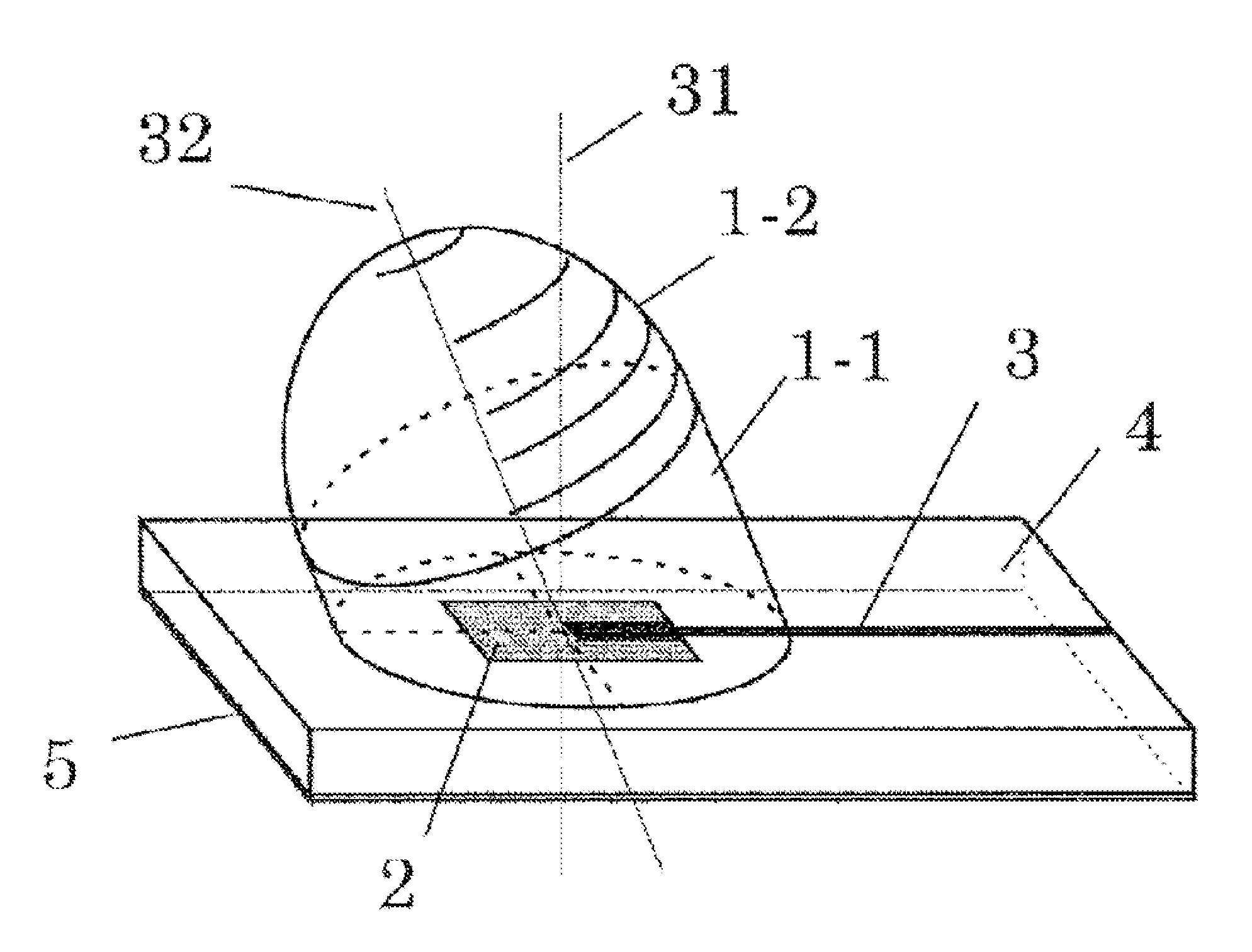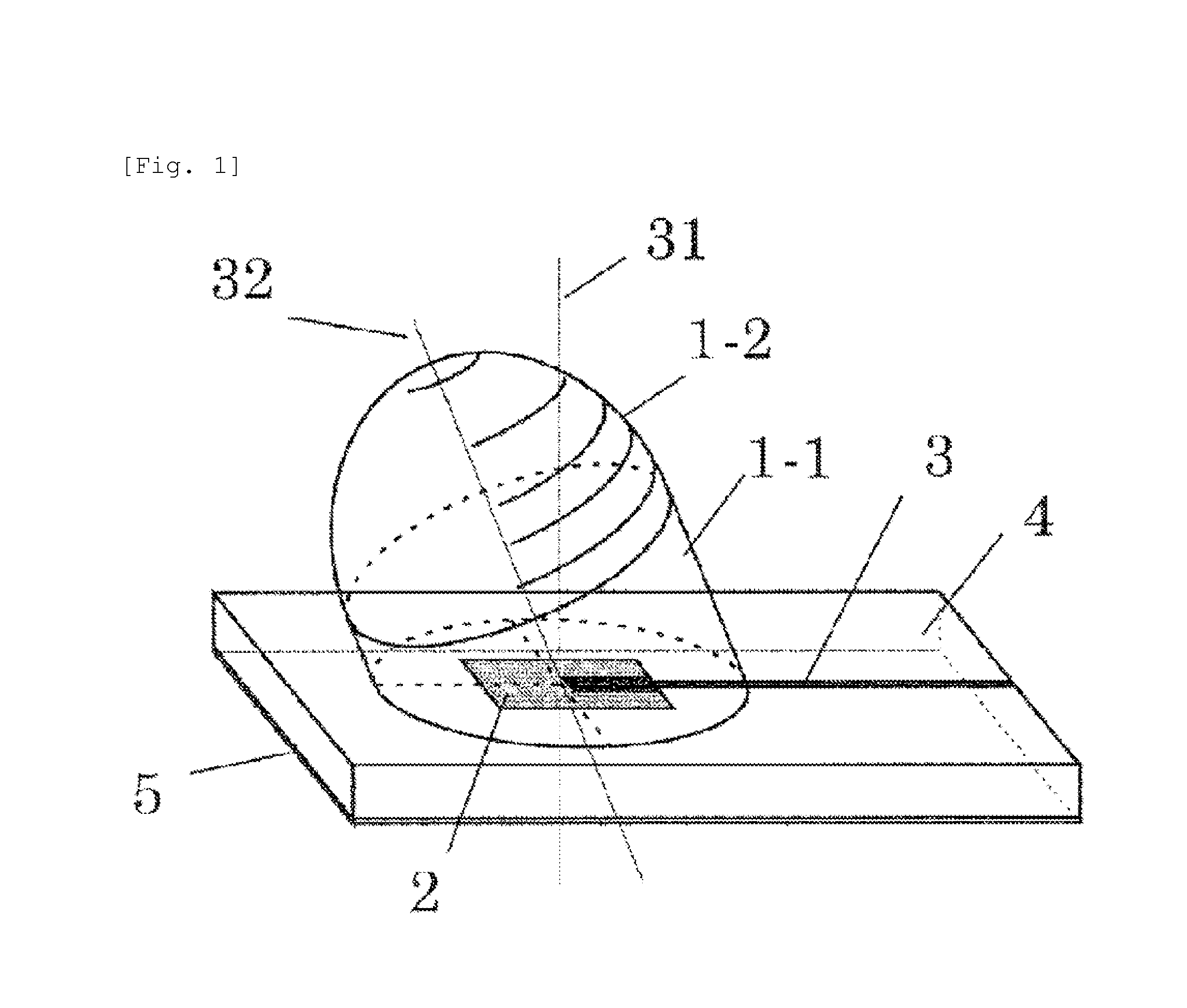Millimeter-Wave Dielectric Lens Antenna and Speed Sensor Using Same
a technology of dielectric lens and speed sensor, which is applied in the direction of using reradiation, instruments, and structural forms of radiating elements, can solve the problems of complex mounting adjustment of speed sensor attached to the frame, and achieve the effect of maximizing the gain of the lens antenna, improving the productivity of the sensor circuit board, and substantially maximizing the gain
- Summary
- Abstract
- Description
- Claims
- Application Information
AI Technical Summary
Benefits of technology
Problems solved by technology
Method used
Image
Examples
embodiment 1
[0039]FIG. 1 is a perspective view of a dielectric lens antenna according to a first embodiment of the present invention. 1 indicates an inclination type cannonball-shaped dielectric lens. 2 indicates one patch antenna. 3 indicates a microstrip line. 4 indicates a mounted board. 5 indicates a GND electrode. The mounted board 4 uses an inorganic board which is formed of ceramics and the like, a single layer board of an organic board which is formed of glass epoxy resin and the like, and a multi-layer board obtained by alternately stacking the boards with a metallic thin film.
[0040]The one patch antenna 2 and the microstrip line 3 are formed on a surface of the mounted board 4. The GND electrode 4 is formed on a lower surface of the mounted board 4 as a facing electrode of the patch antenna and the microstrip line 3. The GND electrode has conductivity and functions to reflect a radio wave which is radiated from the patch antenna to the dielectric lens side.
[0041]A millimeter-wave sign...
embodiment 2
[0056]FIG. 5 is a side view of a dielectric lens antenna of a first example according to a second embodiment of the present invention. 1 indicates an inclination type cannonball-shaped dielectric lens. 2 indicates one patch antenna. 4 indicates a mounted board. 6 indicates a second dielectric lens.
[0057]The second dielectric lens is a unilateral convex surface lens or a dual-sided convex surface lens. The second dielectric lens uses a dielectric lens having a large opening area in order to much more condense a millimeter radio wave which is radiated from the inclination type cannonball-shaped dielectric lens 1.
[0058]FIG. 6 is a side view of a dielectric lens antenna of a second example according to a second embodiment of the present invention. Generally, a radio wave which passes through an optical axis of a lens travels straight without refraction. A radiation direction of beams may be much more inclined using refraction by causing the millimeter radio wave which is radiated from t...
embodiment 3
[0067]FIG. 11 is a perspective view of a speed sensor of a first example according to a third embodiment of the present invention.
[0068]1 indicates an inclination type cannonball-shaped dielectric lens, 2 indicates one patch antenna, 4 indicates a mounted board, 11 indicates a millimeter-wave band RF circuit, and 12 indicates an Analog / Digital Converter (ADC) or a Digital / Analog Converter (DAC). 13 indicates a Digital Signal Processing Unit (DSP) and 14 indicates a Power Unit.
[0069]FIG. 12 is a circuit configuration diagram of the speed sensor illustrated in FIG. 11. A millimeter-wave signal which is generated by the RF circuit portion 11 is radiated from a Tx / Rx antenna 15 which is formed from the dielectric lens 1 and the one patch antenna. The radiated signal reaches and is reflected by a measurement object which is a target. The reflected signal is received by the Tx / Rx antenna 15 again.
[0070]The received millimeter-wave signal includes a Doppler signal by a difference in a rela...
PUM
 Login to View More
Login to View More Abstract
Description
Claims
Application Information
 Login to View More
Login to View More - R&D
- Intellectual Property
- Life Sciences
- Materials
- Tech Scout
- Unparalleled Data Quality
- Higher Quality Content
- 60% Fewer Hallucinations
Browse by: Latest US Patents, China's latest patents, Technical Efficacy Thesaurus, Application Domain, Technology Topic, Popular Technical Reports.
© 2025 PatSnap. All rights reserved.Legal|Privacy policy|Modern Slavery Act Transparency Statement|Sitemap|About US| Contact US: help@patsnap.com



